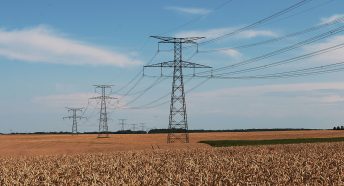How we all stand to lose as our council-owned farms disappear

Council-owned county farms are in terminal decline, which means future generations of young farmers – and our communities more broadly – won’t benefit from these wonderful assets, according to a new report launched today (Monday, December 16) by CPRE.
County farms were set up at the end of the 19th century to provide a way into farming for young farmers and have huge potential to generate income, provide an opportunity to promote innovative farming methods and deliver environmentally sustainable farming to help tackle the climate emergency.
Their decline is significant, with the area of county farms in England falling by more than half from 426,000 acres to just under 209,000 acres since the late 1970s – as a result of privatisation, austerity and short-term thinking by governments and councils.
More than 15,000 acres (7 per cent) of council-owned farmland has been lost in the past decade alone, with 60 per cent of this land sold off in the past two years. This alarming trend, warns the report, could continue unless new legislation that protects county farms for future generations is introduced.
However, the key findings from Reviving county farms, which is a report prepared for CPRE by the New Economics Foundation, Shared Assets and Who Owns England?, show that:
• More than 50 per cent of county farm
estates have disappeared over the past 40 years
• More than 15,000 acres (7 per cent) of this
has been lost in the past decade alone
• Almost 60 per cent of county farmland sold
since 2010 has been in the past two years
• Austerity, coupled with a sense that county
farms are ‘a thing of the past’, and an unwillingness by some councils to innovate
to develop new income streams or business models, is driving the decline of
county farms
• Councils that have taken very different
approaches, leading them to protect and even expand their county farm estates,
have yielded positive results
• County farms could play an important role
in addressing the climate emergency and also deliver benefits to local
communities, such as providing locally-grown food for nearby schools
• Seven out of nine councils that responded
to the survey gave details of environmental and social benefits provided by
their county farms, ranging from tree-planting to local education initiatives
to supporting new farmers.
Case study
Whitehall Farm is a 100-hectare farm owned by Cambridgeshire County Council and managed by Stephen Briggs on a 15-year tenancy, along with more than 300 hectares of other land.
Briggs has taken an innovative agroforestry arable crops approach to build the profitability, resilience and sustainability of the farm.
He has interplanted arable crops with 4,500 apple trees that provide an income and protect soil and growing crops from the risk of extreme weather as a result of the climate emergency.
Birds such as grey partridge, owls, tree sparrow, reed bunting and yellowhammer are flourishing in the environmentally sensitive farmland.
Briggs and his wife Lynn have also opened Harvest Barn farm shop and café on their county farm site. The shop sells local and certified organic fresh fruit and vegetables from the farm as well as locally sourced lamb, beef and pork, cakes and biscuits and jams and preserves.
Briggs said: “Thanks to the county farms system, I have been able to run my own farm and try an innovative and successful soils-based farming approach.
“The support I have received from my local county council has been invaluable. I’d like to see all local authorities encourage new entrants with fresh ideas and perspectives like me to go into agriculture to keep this wonderful resource in the community as a vital asset.
“There are economic incentives for councils, too, as the rent from our county farm and its innovative diversifications goes straight back to the county council, helping fund front-line services.”
Graeme Willis, agriculture lead at CPRE, said: “Whitehall Farm is a great example of a county farm having an economic, environmental and social impact.
“Our research shows that the number of county farms in England alarmingly continues to plummet at a time when these wonderful assets should be protected, and invested in, to ensure they’re available for future generations.
“CPRE is calling on the new government to introduce legislation to stop the sale of county farms and to give them a new purpose.
“A package of measures and new funding to enable councils to enhance and invest in their estates and better promote them is urgently needed.
“CPRE wants to see county farms recognised locally and nationally for their potential to address the climate emergency and deliver wider public benefits to meet the needs of their communities.”
Kate Swade, report co-author, said: “The sell-off of the county farms estate is a national tragedy, squandering a public resource that is crucial to getting fresh blood into farming. Enough is enough: it’s time the new government halted the sale of county farms and invested in them properly for the future.”
Monday, December 16, 2019
- A number of important documents have yet to emerge. For example, a rigorous transport plan and a finalised air-quality assessment. The latter is critical given that allocations at Teynham will feed extra traffic into AQMAs.
- There seems to be no coherent plan for infrastructure delivery – a key component of the plan given the allocations being proposed near the already crowded Junction 7.
- There seems to have been little or no cooperation with neighbouring boroughs or even parish councils within Swale itself.
The removal of a second consultation might have been understandable if this final version of the plan were similar to that being talked about at the beginning of the consultation process. It is, however, radically different in the following ways:
- There has been a major shift in the balance of housing allocations, away from the west of the borough over to the east, especially around the historic town of Faversham. This is a move that raises many concerns.
- A new large allocation, with accompanying A2 bypass, has appeared around Teynham and Lynsted, to which we are objecting.
- Housing allocations in the AONB around Neames Forstal that were judged “unsuitable” by the council’s own officers have now appeared as part of the housing numbers.
- Most of the housing allocations being proposed are on greenfield sites, many of them on Grade 1 agricultural land – a point to which we are strongly objecting.
Concerns about the rush to submit the plan
The haste with which the plan is being prepared is especially worrying given the concentration of housing in Faversham. If the town is to take a large amount of new housing, it is imperative that the policies concerning the area are carefully worked out to preserve, as far as possible, the unique nature of the town. The rush to submit the plan is likely to prove detrimental.
As Swale does not have a five-year land housing supply, it is open to speculative development proposals, many of which would run counter to the ideas contained in the current plan. Some are already appearing. This is a common situation, and one that, doubtless, is a reason behind Swale’s haste.
Our overriding fear, however, is that this emphasis on haste is ultimately going to prove counterproductive. This is because it is our view that the plan, in its current form, is unlikely to pass independent examination. We are urging Swale to listen to and act upon the comments being made about the plan and to return the plan to the council with appropriate modifications before submitting it to the Secretary of State.
Essentially, this means treating the current consultation not as the final one but as the ‘lost’ second consultation.
The consultation ends on Friday 30 April and we strongly urge residents to make their opinions known if they have not already done so.
Further information








